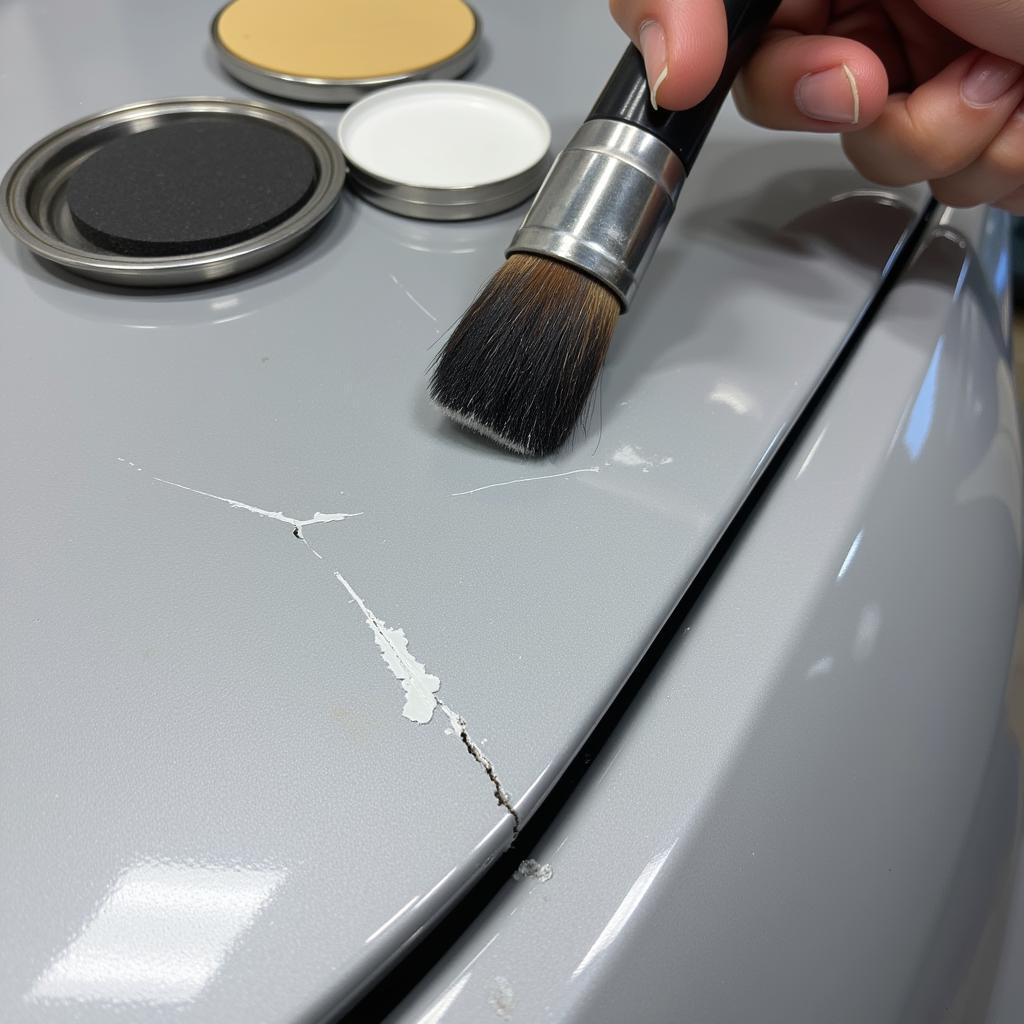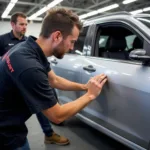Car paint damage, whether a minor scratch or a deep gouge, can be an eyesore and potentially lead to rust. Knowing how to repair car paint damage not only improves your car’s appearance but also protects its value and longevity. This guide will cover various types of car paint damage and effective DIY repair methods.
Learning how to assess and address these issues can save you significant money compared to professional repairs. We’ll walk you through everything from identifying the damage to choosing the right repair method and applying it correctly. Let’s dive in!
how to repair car paint damage at home
Identifying the Type of Car Paint Damage
Before starting any repairs, correctly identifying the type of damage is crucial. This will determine the appropriate repair method and ensure optimal results. Common types of damage include:
- Scratches: These range from clear coat scratches to deep scratches that penetrate the paint layers.
- Chips: Small pieces of paint chipped off, often due to rocks or road debris.
- Scuffs: Superficial damage caused by rubbing against another object.
- Swirl Marks: Fine scratches that create a hazy or spiderweb-like appearance, often caused by improper washing techniques.
- Fading and Oxidation: Dull, chalky appearance caused by sun exposure and environmental factors.
DIY Car Paint Repair Methods
Once you’ve identified the damage, you can choose the appropriate repair method. Here are some common DIY techniques:
Repairing Minor Scratches and Scuffs
For minor scratches and scuffs, a simple car polish or rubbing compound can often do the trick. Apply the compound to a microfiber cloth and gently rub it onto the affected area using circular motions. This can remove light scratches and restore shine.
Fixing Paint Chips
Paint chips require slightly more attention. Clean the chipped area and apply touch-up paint precisely using a fine-tipped brush or a touch-up pen. Allow the paint to dry completely and then use rubbing compound to blend the edges with the surrounding paint.
Addressing Deep Scratches and Gouges
Deep scratches that reach the primer or metal require a more involved approach. You’ll need to sand the damaged area, apply primer, and then apply several thin coats of touch-up paint.
 Repairing a Deep Scratch on Car Paint
Repairing a Deep Scratch on Car Paint
Removing Swirl Marks
Swirl marks can be removed using a specialized swirl mark remover and a dual-action polisher. This process requires careful technique to avoid further damage to the paint.
Restoring Faded and Oxidized Paint
Faded and oxidized paint can be restored with a polishing compound or a dedicated paint restoration product. These products remove the oxidized layer and restore the paint’s original shine.
how to repair sun damaged paint on car
Tools and Materials for Car Paint Repair
Having the right tools and materials is essential for successful car paint repair. Here’s a list of essential items:
- Microfiber cloths
- Car wash soap
- Rubbing compound
- Polishing compound
- Touch-up paint
- Primer
- Sandpaper (various grits)
- Masking tape
- Applicator pads
- Fine-tipped brush or touch-up pen
Expert Advice from John Smith, Automotive Paint Specialist
“Always start with the least aggressive method and gradually increase the intensity if needed. Over-sanding or using the wrong products can worsen the damage.”
When to Seek Professional Help
While many minor paint repairs can be handled DIY, some situations require professional assistance:
- Extensive damage covering a large area.
- Deep dents or rust.
- Damage to complex areas like bumpers or curves.
- Lack of confidence in your DIY skills.
Conclusion
Learning how to repair car paint damage empowers you to maintain your vehicle’s appearance and protect it from further damage. By following the steps outlined in this guide, you can tackle various types of paint issues and achieve professional-looking results. Remember to always assess the damage accurately and choose the appropriate repair method. If you’re unsure or dealing with significant damage, seeking professional help is always recommended. Proper car paint maintenance not only enhances your car’s aesthetics but also preserves its value in the long run.
FAQs
- How can I prevent car paint damage?
- What is the best way to wash my car to avoid swirl marks?
- Can I use household cleaners to clean my car’s paint?
- How often should I wax my car?
- What is the difference between rubbing compound and polishing compound?
- How long does touch-up paint take to dry?
- Can I repair clear coat damage myself?
Expert Advice from Maria Garcia, Certified Car Detailer
“Regular washing and waxing are crucial for protecting your car’s paint and preventing damage from UV rays and environmental contaminants.”
how to repair car paint damaged by bird poop
Common Car Paint Damage Scenarios
- Scratches from tree branches or car keys
- Rock chips on the hood or bumper
- Scuff marks from parking lot mishaps
- Bird droppings etching into the paint
- Sun damage causing fading and oxidation
Related Articles and Resources
Check out these other helpful articles on our website:
- Protecting Your Car’s Paint in Winter
- Choosing the Right Car Wax for Your Vehicle
- DIY Car Detailing Tips and Tricks
bird poop car paint damage repair uk
Need further assistance? Contact us via WhatsApp: +1(641)206-8880, Email: [email protected]. We have a 24/7 customer support team.


